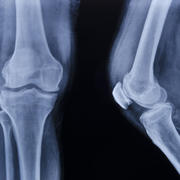
As we age, every stumble or fall comes with a risk—a risk that is even greater for those ten million people in the U.S. who have osteoporosis, a skeletal disease characterized by low bone mass, poor bone quality and fractures. Each year, 1.5 million bone fractures are attributed to osteoporosis, including 350,000 hip fractures. But hip or other fractures in older and osteoporotic patients do not heal easily and this often leads to significant impairments in daily life, and even death.
Dr. Roland Baron, professor and chair of the Department of Oral Medicine, Infection, and Immunity at Harvard School of Dental Medicine (HSDM), Division of Bone and Mineral Research, and professor of medicine at Harvard Medical School (HMS), and his research team collaborated with the research team of Dr. Superti-Furga, professor of pediatrics at the University of Lausanne in Switzerland, to study cortical bone fragility. Cortical bone is the hard outer layer of bone that becomes more susceptible to fracture in people with osteoporosis. Their findings, recently published in The New England Journal of Medicine in the article Cortical-Bone Fragility — Insights from sFRP4 Deficiency in Pyle’s Disease, may shed light on the causes of and potential treatment for cortical-bone fragility.
Studying genetic disorders of the skeleton can often lead to greater insights on common skeletal ailments such as osteoporosis. Dr. Pelin Simsek Kiper from the University of Lausanne and Drs. Hiroaki Saito and Francesca Gori from HSDM (co-first authors) studied Pyle’s disease, a human genetic disorder characterized by increased amounts of trabecular bone, cortical bone thinning and limb deformity, and identified a recessive genetic mutation in SFRP4, a Wnt signaling inhibitor, that causes the disease. The team reproduced the genetic deletion in mice and demonstrated that trabecular and cortical bone compartments are differentially regulated and that proper crosstalk between Wnt and Bmp signaling is critical for cortical bone homeostasis. In addition, the team experimented with reversing the effects of SFRP4 deficiency in mice with pharmacologic treatments. Interestingly, specific treatments significantly improved bone mineral density, and corrected the cortical-bone defect.
“One of the most interesting aspects of our findings is the demonstration that the regulation of trabecular bone, the main component of vertebrae, and of cortical bone, predominant in long bones like the hip or wrist, differs to some degree,” Dr. Baron said. “This may help explain why some drugs are very efficient in preventing vertebral fractures but not so good for hip fractures and may open a new avenue for research, ultimately refining our diagnostic and therapeutic approaches.”
The team’s findings also highlighted limitations of the most commonly used tools for the diagnosis and evaluation of skeletal diseases, which often cannot properly distinguish these two bone compartments.
“Our studies provide important insights and reasons to explore how Wnt and Bmp signaling regulate bone mass differentially in trabecular and cortical bone. This may offer a platform to further understand Wnt signaling specificity, and to tease out its multiple roles in skeletal development and homeostasis,” Dr. Gori said.
About the Baron Laboratory
The Baron Laboratory at HSDM focuses on signal transduction and the ways in which it controls bone cell differentiation and function. Members of the lab study primarily skeletal development and remodeling as a model system. This work combines in-vitro and in-vivo experiments—often involving genetically modified transgenic or knockout mice and their isolated cells—that integrate molecular, cellular, and in-vivo studies to determine both the molecular mechanisms of cell biology and pathology and the impact of these mechanisms and their alteration at the organ level in normal and disease conditions. This research is directly relevant to several medical issues, including osteoporosis, osteo-arthritis, bone metastasis in cancer and endocrine disorders of calcium and phosphate metabolism.


